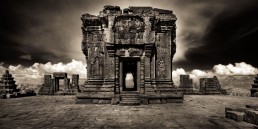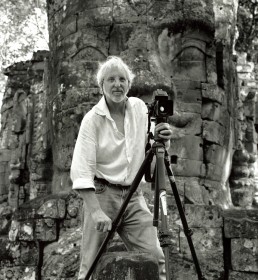John McDermott’s otherworldly pictures of Cambodia's mysterious temple complex capture not only what the eye sees, but what the heart feels.
LIKE THE PHOTOGRAPHY of the late Ansel Adams, whose black-and-white landscapes of Yosemite are the defining images of that Californian national park, John McDermott’s work is strongly tied to one place.
The 61-year-old’s pictures of Cambodia’s wonder-of-the-world Angkor Wat are dreamlike and otherworldly, and yet also realistic representations of what one feels when visiting.
With ghostly monks climbing sandstone steps towards the heavens, 20-metre-high gates looming from primeval jungle, mysterious structures (lairs of the gods, perhaps) floating on seas of clouds, and tentacle-like tree roots consuming temples lost in time, McDermott’s images are arguably the most iconic ever made of the temples, with the New York Times dubbing him “the unofficial court photographer of Angkor”.
HAILING FROM LITTLE Rock, Arkansas, McDermott lives in Siem Reap, the bustling entry-point city for tourists visiting the sprawling Angkor complex. He discovered his 12th-century muse back in 1995, when working for a Bangkok-based magazine. That year, McDermott visited Angkor Wat for the first time to experience a total solar eclipse. “A magical place for a magical event,” he says.
The photographer had been experimenting with specialist film sensitive to infrared light, which is invisible to the human eye. Images captured with infrared film have an ethereal quality: leaves on trees appear luminous, skies darken moodily, the orange robes of monks fluoresce tungsten white, and light sometimes bleeds to give objects supernatural-looking auras.
“It’s hard to work with, not very stable, and a lot of photographers gave it a try but didn’t really get into it,” McDermott says. “I wanted to see what would happen to the film before, during and after the eclipse.”
Having taken up position on the right side of the causeway leading towards Angkor Wat, McDermott waited for the moon to pass across the sun. “As [an eclipse] gets closer and closer, colour diminishes and everything becomes monochromatic,” he says, “and just a few seconds before totality hits, the light flutters.”
Already impressed by what he had witnessed, once back in his darkroom McDermott had his “eureka moment”.
‘WHEN I LOOKED at all the pictures, the infrared were the ones that had a sort of spirit or soul to them,” he says of the specialist film, manufacture of which has long since been discontinued (McDermott has about 200 rolls left, stored in his freezer). “They had a surreality that spoke to me, that captured the place as it looked to me at the time — the feeling, the experience.
“I always envision places like Angkor, like Pagan [in Myanmar] and some other historical places in Asia as remnants of an ancient civilisation, or even of an alien civilisation — like Star Trek backgrounds — and I really wanted to capitalise on that idea and make the pictures as surreal as possible. Angkor and the infrared film proved a good match.”
Five years later, McDermott returned to Siem Reap for an exhibition of his work at the newly re-opened Raffles Grand Hotel d’Angkor.
“I needed to photograph the temples soon, before the invasion happened and things would never look the same again”
Photographer John McDermott
“It was a little exhibition, just for fun, but it ended up selling out,” he recalls. “I’d been looking for a project to get my teeth into, and I realised then that interest in Angkor was building, and that there was going to be a tourism boom. I needed to photograph the temples soon, before the invasion happened and things would never look the same again.”
McDermott spent much of 2000 and 2001 flitting back and forth from the US to shoot Angkor Wat, the Bayon, Ta Prohm and other temples, gradually developing his characteristic style, and financing his project with further exhibitions. “By 2004, tourism had really grown,” he says. “By then I had a big collection of pictures and was having regular exhibitions around town.”
The upmarket FCC Angkor restaurant and bar on the banks of the Siem Reap River, he continues, had opened some shops on the ground level. “I got offered one, so I called [my wife] Narisara, who was then about to leave grad school in the US, and said, ‘Do you wanna go into the gallery business?’”
TODAY THE COUPLE and their two young children, Mars and Rose, are comfortably settled in Siem Reap. They have two galleries — that original space at the FCC and another in the Raffles.
McDermott admits that he shoots Angkor less often these days due to the sheer number of visitors to the temples and the ongoing restoration work. Even so, the second edition of his exquisite Angkor-photography book Elegy — funded by a Kickstarter campaign that generated more than US$100,000 — includes pictures taken as recently as 2014.
“The aesthetic has certainly changed,” McDermott says of Angkor. “Is it a fantastic place to visit as a tourist? Yes, sure, but some of the charm, some of the mystery, has gone.”
As well as the galleries, McDermott runs photography excursions for individuals and group workshops open to the public. “In the workshops me might focus on how to build a story or a portfolio,” he says. “The one-on-one excursions are more informal. I take them to places where I know they are going to get good photographs, so they don’t have to do days of research to find them. We don’t get too technical, and they get to see Angkor in a different way.”
Ultimately, it could be argued that McDermott’s own quest to see things in “a different way” has been central to his success, and his Angkor portfolio is a “window in time” that lets in mood and emotion as well as light.
“I wanted to capture more than what I could see — I wanted the gut feeling, the atmosphere and sense of wonder,” he says. “That was my intention from the beginning: to capture the spirit of Angkor as I felt it. I saw it back when it was just ruins and jungle, and it had that mysterious, otherworldly appearance. I wanted that.” ◉
Continued: John McDermott explains his most striking pictures of Angkor
This story ran in Post Magazine in 2017 (see PDF). John McDermott's fine-art and commercial photography can be viewed here.
SHARE




